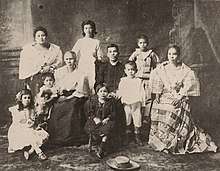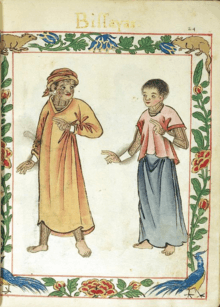Cebuano people
 A Cebuano family from Calle Colon, the oldest street in the Philippines located in Cebu City. | |
| Total population | |
|---|---|
| 3,850,000[1] | |
| Regions with significant populations | |
|
(Central Visayas, Negros Occidental, Masbate, western parts of Eastern Visayas, large parts of Mindanao) Worldwide | |
| Languages | |
| Cebuano, Filipino, English | |
| Religion | |
|
Predominantly Roman Catholicism. Minority others, Aglipayan, Protestantism, Islam, Buddhism, Hinduism, Taoism | |
| Related ethnic groups | |
|
Other Filipinos (Boholano, Waray, other Visayans) other Austronesian peoples |

The Cebuano people (Cebuano: Mga Sugbuanon) are a subgroup of the Visayan people whose primary language is the Cebuano language. They originated in the province of Cebu in the region of Central Visayas, but then later spread out to other places in the Philippines, such as Siquijor, Bohol, Negros Oriental, southwestern Leyte, western Samar, Masbate, and large parts of Mindanao. It may also refer to the ethnic group who speak the same language as their native tongue in different parts of the archipelago.
History
Oceanic or Austronesian people called Malayo-Polynesians settled Cebu island and the rest of the Philippines around 30,000 years ago. Most Cebuanos today have Malayo-Polynesian ancestry. The early Cebuanos developed similar seafaring cultures to the Micronesian people; however, being closer to mainland Asia, Cebuanos also engaged in trade with Japan and Okinawa, India, China, Malaysia, Indonesia, Thailand and Sri Lanka.


The Cebuano language has been spoken since the Proto-Austronesian era (c. 6000 years ago) in the Sugbu (Cebu) heartland.[2] The language "has spread from its base in Cebu" to nearby islands[2] and also Bohol, eastern Negros, western and southern parts of Leyte and most parts of Mindanao, especially the northern, southern, and eastern parts of the large island..[3]
Pintados was the term used by Spanish colonists to describe the tattooed indigenous Cebuano Visayan people.[4] They were found on the islands of Cebu, Bohol, eastern part of Negros, Samar and Leyte in the Biçayas (Visayas) region of the Philippines.[5] The word itself means "painted," and was first used during the Spanish colonization of the Philippines.
The ancient Cebuanos developed a culture with significant influence from mainly Japan, China, India and Borneo.[6] They traded pearls and coral for silk, gold, weapons and spices. The early Cebuanos held animist beliefs and worshipped anitos (spirits) until the introduction of Roman Catholicism.
The famous encounter between explorer Magellan and the local chieftain Lapu-Lapu ended in the death of Magellan at the Battle of Mactan. The Cebuanos held off colonization for a while until a Spanish explorer colonized Cebu and the Cebuanos came under Spanish rule.
Culture and festivities
Along with the rest of the Philippines, Cebu was governed from Spain and Mexico, and as a result received heavy Spanish and Mexican influence. There are thousands of Mexican Spanish loanwords in Cebuano. Mexican and Spanish influence is evident in the cuisine, traditional costumes, dances, music, festivals, traditions and crafts.
Cebuano culture is traditionally characterized as a blend of Malay[7] and Hispanic traditions with influences from Asia and the United States. The majority of Cebuanos are Roman Catholic.[8]
Among the island's notable festivities are the Sinulog[9] festival, which is a mixture of Christian and native cultural elements, celebrated annually every third week of January.
Language
The Cebuano language is spoken by about 25,000,000 people in the Philippines and is the most widely spoken of the Visayan languages. Most speakers of Cebuano are found in Cebu, Bohol, Siquijor, Biliran, Western and Southern Leyte, eastern Negros and most of northern and southeastern Mindanao.
See also
References
- ↑ "Facts and Figures". Cebu Province Official Website.
- 1 2 "John Woff, "Cebuano" in Facts About the World's Languages: An Encyclopedia of the World's Major Languages, Past and Present (New York: H. W. Wilson, 2001). https://archive.org/details/rosettaproject_ceb_detail-2
- ↑ http://www.gutenberg.ph/previews/wolff/WCED-complete.pdf
- ↑ John Kingsley Pangan, Church of the Far East (Makati: St. Pauls), 9.
- ↑ G. Nye Steiger, H. Otley Beyer, Conrado Benitez, A History of the Orient, Oxford: 1929, Ginn and Company, pp. 122-123.
- ↑ "Ancient Japanese pottery in Boljoon town | Inquirer News". Inquirer News. 2011-05-30. Retrieved 2013-02-08.
- ↑ "Countries and their Cultures". Countries and Their Cultures. Retrieved 2014-02-08.
- ↑ "Culture and Lifestyle". Cebu Province official website.
- ↑ "Cebu Philippines Festivals, Fiestas and Cultural Event". eTravel Pilipinas-Discover the Wonders of Island Paradise.